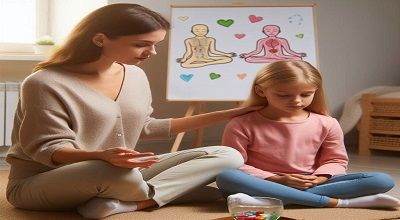Educating Children on Managing Emotions
Educating children on managing emotions and practicing mindfulness is essential for their emotional and psychological development. Here are some key materials and resources that can be utilized to teach these important skills:
Books
For younger children:
- “My Magic Breath: Finding Calm Through Mindful Breathing” by Nick Ortner and Alison Taylor.r This book helps children learn how to control their emotions through breathing.
- “The Color Monster: A Story About Emotions” by Anna Llenas. This is a great tool for helping young children understand and identify their feelings.
For Older Children:
- “A Handful of Quiet: Happiness in Four Pebbles” by Thich Nhat Hanh – Introduces mindfulness practices to children.
- “Mindful Monkey, Happy Panda” by Lauren Alderfer – This book teaches the concept of mindfulness in a simple, accessible way.
Apps and Digital Resources
- Headspace for Kids – Offers meditation sessions tailored for different age groups, focusing on topics like calm, focus, kindness, sleep, and wake-up.
- Stop, Breathe & Think Kids – Designed for children ages 5-10, it offers fun. Engaging activities that help them understand and process their emotions.
Activities and Games
- Mindful Games Activity Cards by Susan Kaiser Greenland – A deck of 55 cards offering fun ways to share mindfulness with kids and teens, focusing on developing attention, balance, and compassion.
- Mood Meter – A tool developed by the Yale Center for Emotional Intelligence that helps children learn to recognize and label their emotions.
Curricula and Programs
- MindUP™ – A comprehensive curriculum teaching social and emotional learning, mindfulness, self-regulation, and positive psychology.
- The Zones of Regulation® – A curriculum designed to teach children self-regulation and emotional control.
Online Resources and Websites
- Mindful Schools – Offers online courses for educators and parents on integrating mindfulness into the lives of children.
- Cosmic Kids Yoga – Provides engaging yoga and mindfulness videos designed specifically for kids, blending storytelling with physical activities.
Tips for Educators and Parents
- Practice Together: Engage in mindfulness and emotional regulation exercises with your children to model these behaviors.
- Create a Calm-down Corner: Designate a space at home or in the classroom where children can go to practice calming techniques or take a moment to process their emotions.
- Daily Check-ins: Start or end each day with a check-in on how everyone is feeling. This can be done using mood charts or simply by sharing thoughts and emotions.
Final Words
Using a combination of these materials and approaches can provide children with a robust set of tools to understand, manage, and express their emotions healthily and constructively. Incorporating mindfulness and emotional education into children’s daily routines can help foster resilience, empathy, and well-being throughout their lives.
